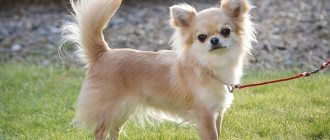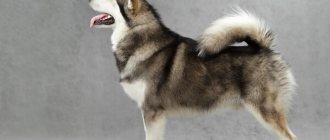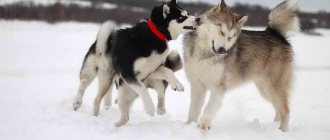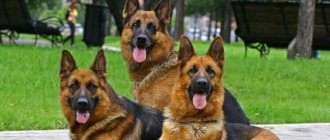To a layman's eye, the German Shepherd and the East European Shepherd are so similar that they appear to be the same breed.
But, despite the external similarity and common origin, these dogs are completely different both in their character and temperament, and in their service use.
And externally, if you look closely, the “German” and the “Eastern” are not so similar.
Which of them is better and who is better to have as a friend and guard?
Let's find out everything in the article.
Briefly about the German Shepherd
Description of the breed
This is one of the most famous dog breeds in the world, if not the most famous. Despite the fact that the original purpose of German Shepherds was to herd livestock, the characteristics of their character and temperament made these dogs suitable for any service.
“Germans” not only serve in the army and police, but also work as rescue dogs or guides for the blind.
German Shepherds also go in for sports, and they can master any kind of sports. And, of course, German shepherds are wonderful guards and bodyguards.
It is not surprising that all over the world these dogs are most often chosen as guards for private houses and city apartments. After all, the endurance and unpretentiousness of shepherd dogs make them suitable for living in a wide variety of climatic conditions.
The German Shepherd is large in size: it is 50-65 cm, and its weight can reach 30-50 kg .
Her body format is somewhat stretched out, but at the same time the dog looks harmonious and not too squat. The length of the head is approximately equal to 40% of the height at the withers, while the skull and muzzle are equal in length.
From above, the head resembles a wedge: wide at the top, it tapers towards the nose. The ears of the German Shepherd are not very large, erect, in the shape of a triangle with a wide base.
The eyes are oval, the look is intelligent and alert. The nose is quite large and black. The neck is strong, strong and muscular. The withers are well defined, the line of the back is even, slightly lowered.
The croup slopes down and meets the base of a saber-shaped, slightly curved tail . The forelimbs are smooth and straight, the hind limbs are strong and muscular.
The color can be black, dark or light gray, black and tan, zoned, saddleback, and also red of various shades. White German Shepherds are also bred in America, but this color is not recognized in Russia.
The German Shepherd can have both coarse and relatively short hair, and longer, forming fringes on the ears, limbs and tail..
Advantages and disadvantages
pros:
- Smart and easy to train.
- He is distinguished by exceptional devotion.
- Unpretentious - easy to maintain.
- They treat children well.
- They are able to distinguish a “work” situation from an everyday one.
- Well guarded.
- A versatile service dog suitable for any job or sport.
Minuses:
- It is necessary to seriously engage in training.
- The German Shepherd needs a lot of physical exercise.
- Not a lap dog, but a working dog who should have his own business.
- May show excessive aggression if improperly raised.
- Dogs of this breed can be hyperactive.
- Nervous breakdowns are possible during overtraining.
Character
The German Shepherd is an attentive, obedient and incorruptible service dog known for its courage and determination.
Quite angry and distrustful of strangers, at the command of the owner she is ready to attack the intruder at any moment.
At home, she is calm and friendly towards the owner and members of his family.
Oriental Shepherd and German mix
Mixed breeds VEO and NO have large body sizes. The height of males is 70-75 cm, weight – up to 60 kg. Bitches weigh 50-55 kg, height at the withers is up to 70 cm. Build is harmonious:
- the back is wide with a short rump;
- the slope is less pronounced than that of the Germans;
- the tail is lowered, sometimes bent into a ring;
- the coat is hard, short, the undercoat is thick and lighter than the coat;
- color black or zoned with a mask and saddle of different shades;
- security qualities are excellent;
- High intelligence, easy to educate and train.
If the dog breeder’s plans do not include the goal of participating in exhibitions with the pet, you can safely get a mestizo, which is in no way inferior to the main breeds in any of the characteristics, but only balances them.
Briefly about the East European Shepherd
The East European Shepherd was bred on the basis of the German Shepherd breed in the 20-30s of the 20th century.
When creating the “Easterns,” the main goal was to breed the ideal dog for service in the army and law enforcement agencies, which is why the emphasis was placed on large stature, endurance and physical strength, for which the dogs were crossed with huskies and some breeds of mastiffs.
As a separate breed, the East European Shepherd was recognized only in 1976, despite the fact that already around the 1930s, mainly dogs of this type were bred in the country.
The East European Shepherd is a large dog, whose height is 62-76 cm at the withers. In terms of the shape of the head and general proportions of the body, it is not much different from the German Shepherd, except for the fact that the “German” has a pronounced back, while the “Eastern” has a straight back.
The coat is dense, hard, and medium in length. The undercoat is shorter than the spine and well developed.
The most preferred colors: black and black . Zone-gray and zone-red are allowed by the standard, but are not very desirable.
Advantages and disadvantages
pros:
- Calm and balanced.
- Smart and understanding.
- Differs in devotion to owners.
- Understands when it is time to stop pursuing the offender and return to the owner.
- Patronizing towards children.
- An excellent security guard and watchman.
- Even an elderly person or a teenager can cope with her training.
- Doesn't get into a rage while working, but carries out commands with maximum concentration.
Minuses:
- Serious training is required.
- She may be overly distrustful of strangers.
- Not universal.
- Puppies of this breed are more difficult to raise due to their large size and accelerated growth.
- Sometimes they are very stubborn.
- They like to show independence.
Character
East European Shepherds are calm and balanced. They take their work seriously and responsibly. These dogs have a strong protective instinct, which makes them excellent watchdogs.
Very intelligent and have an excellent memory, just like Belgian Shepherds.
During training and professional use, problems can only arise due to their stubbornness and excessive independence.
Children are treated patronizingly.
They do not harm other people's dogs and other animals, unless they themselves annoy them..
Origin story
The history of the German Shepherd (GSD) dates back to the fourth century. It is believed that their ancestors were an Indian wolf and a European dog of an unknown breed. The Hofovarites, as they were called, became guards and shepherds for the livestock. The German Shepherd received its modern appearance at the end of the nineteenth century and quickly became popular in Europe. In Germany, they began to seriously select the breed and gradually bred individuals that interacted well with people and other animals. From that moment on, they began to be used as service ones.
The East European Shepherd (VEO) was bred at the beginning of the twentieth century in the USSR. The Germans did not tolerate both the severe Siberian frosts and the heat. A breed was needed that was more resistant to climatic conditions than the Western European type shepherd dog. She was crossed with huskies and Caucasians and got a large, strong, obedient dog with high service qualities.
What are the differences?
East European Shepherds are larger and more massive than German ones: their height is about 10 cm greater. But the main external difference between these two breeds is their structure.
If the “German” has a back inclined from the withers to the base of the tail, then the “Eastern” has practically no slope.
In addition, the front limbs of the German Shepherd are longer than the hind limbs, while the Eastern European has all the legs of approximately the same length.
The type of movement is another external difference.
“Germans” move at a measured and free trot, and “Easterners” move at a sweeping and fast gait.
These breeds also differ in temperament: German shepherds are choleric, while Eastern European dogs are phlegmatic. And, if the former are distinguished by impetuosity and speed of reaction to an immediate threat, then the latter are calm and unperturbed.
German Shepherds act impulsively when detained and, if they get into a rage, it can be difficult to stop them.
The East European Shepherd acts deliberately and carefully: it monitors the actions of the detainee and therefore it is not easy to take him by surprise.
“Germans” are a universal breed, but “Easterns”, originally bred for protection, are mainly used as watchdogs.
How do puppies of these breeds differ?
Both shepherd dogs can perform the same functions: be guards, companions and communicate with children. When deciding which breed to choose, first of all take into account the character of your future pets. It is better if it matches your lifestyle and habits:
- For active people involved in sports, the German Shepherd is more suitable;
- VEO is more suitable for a quiet life, is better socialized, and can be an excellent companion for a lonely person.
Young puppies have the same external differences as adult animals:
- The VEO has a straight back line, while the Germans have a slope.
- Eastern European puppies are taller and heavier.
Table: comparison of height and weight of puppies in the first months of life (average values)
| East European Shepherd, height/weight | German Shepherd, height/weight | |
| 1 month | 25 cm/4 kg | 20cm/3.6kg |
| 2 months | 36 cm/9 kg | 35cm/8.2kg |
| 3 months | 45 cm/14 kg | 44 cm/13.2 kg |
How to buy puppies
Like any purebred dog, it is better to purchase shepherd dogs from kennels or through cynological organizations. In Russia there are kennels for both shepherd dogs.
Video: results of training East European Shepherds
The price of a pet depends on its class. The breed (for breeding) and show (for exhibition) categories are valued much more expensive than ordinary pets (pet class). The cost of puppies ranges from:
- for East European Shepherds - from 10 to 35 thousand rubles;
- for German - from 10 to 55 thousand rubles.
Shepherd dogs have always been popular in the former Soviet Union. And their fame is well deserved. There are differences between German and East European Shepherds, but no matter what breed you choose, it will be a loyal friend and protector.
How are they similar?
- Both of these shepherds are smart, quick-witted and highly trainable.
- They both have a protective instinct by nature.
- Both the “German” and the “Eastern” are able to sense the mood of the owner and act in accordance with it.
- Both breeds are distinguished by strength, endurance, courage and viciousness, as well as distrust of strangers.
- Both dogs are unpretentious to living conditions.
NOTE!
With proper training, both the “German” and the “Eastern” make wonderful working dogs: loyal, reliable and hardy.
Character and intelligence
Several years ago, information persistently leaked on the World Wide Web that likes were used in the formation of modern VEOs. The current representatives of the breed are endowed with an amazing sense of smell, but a choleric character; they are called East Siberian Shepherds. This is an outright lie, because huskies are in no way related to this breed. In the Republic of Belarus they were breeding their own dogs in the 1960s of the last century. Then they mixed the old-type German shepherd with the Asian, husky and several other breeds. But the resulting dog was not recognized by all kinds of canine organizations.
Representatives of the breed are used in the service of the Ministry of Internal Affairs, search and rescue teams, and act as guide dogs (occasionally, but it happens). According to the majority of breeders and owners of “Eastern dogs”, they have no equal in intelligence, the dogs learn easily and quickly, are ready to work at any time of the day, and the need to serve the owner is clearly expressed.
The temperament of the East European Shepherd dog breed is considered ideal, according to the conclusions of the great I.P. Pavlov, who identified four of its types. Strong, balanced, agile - this is about “Easterns”. The processes of excitation and inhibition are approximately the same, representatives of the breed work well in dynamics, but statics do not suffer either.
Animals are balanced, calm and self-possessed. A lively mind allows them to figure out how to behave in a given situation. Numerous Soviet films, including such well-known ones as “The Border Dog Scarlet” and “On a Leash at the Runway,” featured East European shepherd dogs. This clearly shows their devotion to people and their ability to make independent decisions when in a critical situation.
Attitude towards children and others
According to the characteristics of the East European Shepherd breed, its representatives adore children. A patient and patronizing attitude towards the little ones encourages parents to have “Easterns”. If you are purchasing a dog as a nanny, it is better to look at a different breed. Despite her love for children, VEO was bred for other purposes.
You can entrust an East European Shepherd with a child without worrying about him being scared or bitten. The dog will put the little bully in his place by growling slightly at him or simply stepping aside, turning away and throwing the child's hands off his back until he calms down.
As for their attitude towards strangers, East European Shepherds are distrustful by nature. This does not mean that a representative of the breed will bark or rush at a stranger at the first opportunity, but the latter’s attempt to get acquainted will be stopped. To do this, you don’t have to bite, just raise your upper lip and show huge, white fangs or grunt in your gut at a stranger.
With the normal behavior of an outsider, the “Eastern” himself will take the initiative. He will come up, sniff, wag his tail, allowing himself to be petted. Can sit next to you, observing a person’s actions. As soon as he shows excessive interest in the dog, he will receive a worthy rebuff.
The animal is ready to attack if the life or property of the owner is threatened. Here it turns into a formidable defender, capable of knocking down a villain and holding him off for as long as necessary. If necessary, the East European Shepherd will bite the robber.
Attitude towards pets
The characteristics of the East European Shepherd breed are such that its representatives are calm towards other pets. When a puppy is brought into a house where dogs already live, he quickly finds a language with the older generation, observing the hierarchical ladder. Just don’t leave your baby alone with adult animals; you need to supervise their play together. Not all dogs love puppies; the attitude towards younger ones does not depend on gender. There are males who look after the younger generation and females who are ready to tear the little ones apart.
Cats and a puppy are capable of making friends, just like an adult “oriental” with a kitten. In the first case it will be more difficult, because a curious child will certainly want to find out more closely what kind of marvelous beast is in front of him. Vaska or Murka will consider the little one’s curiosity as familiarity and will immediately point the new resident to his place. Although a lot depends on the character of the cat, others will prefer to sit higher up, looking sideways at the puppy, and some will accept the baby and begin to care for him as if he were their own.
It is difficult to say anything regarding rodents and aquarium fish. Depending on the character of the dog, many representatives of the breed consider rats and hamsters as a source of prey.
Which breed is best suited for living in an apartment?
A German Shepherd is more suitable for apartment living, since a more powerful and heavier “Eastern” dog will be uncomfortable in an apartment.
It is recommended to keep such a dog as a guard for a private home.
Expert opinion
Kozhevin Semyon Kirillovich
Expert dog handler.
“When deciding who is better to get - a German or East European shepherd, you need, first of all, to focus on the purpose and temperament of these dogs. The German Shepherd is more active and impulsive, while the Veo is calm and balanced. Representatives of both breeds can guard the house, but the “German” is more suitable for apartment maintenance. If we are talking about buying a future exhibition champion or winner of a sports competition, then, of course, you need to get a German shepherd.”
Briefly about the VEO breed
When Soviet Russia needed large, friendly dogs with excellent working qualities, the choice was made in favor of German shepherds. They served as the base breed for a new type of dog, designed to replace the light German type with serious dogs, suitable, first of all, for military service in various climatic conditions, and then for other “needs of the national economy.”
Planned, targeted selection to improve dogs imported from Germany began in 1924.
The dog was literally “calculated” by domestic breeding specialists from the Service Dog Breeding section of the All-Khotsoyuz. A little later (1928-30), breeders of Osoaviakhim and departmental nursery schools for breeding service breed dogs joined their work.
Over 4 decades, departmental nurseries and public organizations have done a tremendous amount of work to improve the constitutional characteristics and develop the desired performance qualities of the German Shepherd.
The resulting large group of purebred dogs differed sharply from German standards, clearly passing on their improved qualities to their descendants.
These external differences and qualitatively different working qualities, which emerged as a result of long-term focused work with the German Shepherd, allowed the Canine Council of the USSR Ministry of Agriculture to accept a new breed, like the East European Shepherd Dog in 1964, with the establishment of a fixed unified standard for it - the VEO breed type.
Who is easier to maintain and care for?
Caring for the “German” and the “Eastern” is almost the same: both dogs need regular brushing (3-4 times a week, and daily during shedding).
They also need to clean their eyes and ears if necessary, and in order to clean their teeth, give them special chewing toys . Nails should only be trimmed if they do not wear down on their own.
Representatives of both breeds are bathed no more than once every 2-3 months.
Cost of dogs
Several factors influence the price of puppies:
- purebred;
- pedigree;
- health;
- compliance;
- availability of documents;
- image of the nursery.
The cost of dogs of both breeds is approximately the same: for pet-class puppies they ask for 15,000 rubles, breed-class will cost the buyer 20,000-30,000 rubles, show class costs 30,000-40,000 rubles.
Attitude towards children and pets
The German Shepherd treats children as equal playmates, but at the same time does not particularly like their pestering and does not tolerate being annoyed. The East European Shepherd treats children patronizingly: it takes care of and protects them.
Representatives of these breeds treat pets differently.
The “Germans” try not to offend cats unless they offend them themselves. Other dogs are only tolerated, and small animals are treated as potential prey.
“Easterners” are calmer and treat any other animals quite loyally.
In order for the dog to treat other pets normally, you need to introduce the puppy to them as early as possible, without allowing conflicts..
Types of colors
The following colors are found in both breeds:
- black-backed - a large dark area on the back in the shape of a mantle, descending to the elbows and sides and a mask on the muzzle;
- black is a rare color. Characterized by a solid coat color;
- zoned with tan marks – original color. The basis is a gray tone. A special feature is the ring coloring of the hair. The range of colors is varied.
Light and white wool, as well as plain red, is a defect in shepherd dogs. Such dogs are disqualified and not allowed to compete or breed.
Who is more picky about feeding?
The German Shepherd can be fed with ready-made high-quality food no lower than premium. These dogs can also eat natural food based on animal protein products.
Experts recommend feeding the East European Shepherd with natural food..
Due to the fact that such large dogs have problems with the musculoskeletal system during periods of active growth or in old age, you need to give them enough soft cartilage and add drugs with chondroprotectors to their food, which the veterinarian will recommend.
Working qualities
The differences between the German Shepherd and VEO are also evident in their work. BUT – plastic, suitable for any professional and sports discipline. Easterners are born watchmen and security guards, and they have difficulty mastering other skills.
The differences are visible when apprehending criminals. The Germans go into a frenzy, they try to catch up and capture the intruder at any cost, often they do not see or hear anything around. Easterners are always “in touch”, vigilant to little things. Therefore, they instantly switch to the owner, notice other intruders, and track the movements of arms and legs.
But with a long pursuit, the BUTs win. Shepherd dogs from Germany tirelessly follow the scent for 2-4 hours, and the domestic breed gets tired in less than an hour.
The Germans also beat the Easterners in sports disciplines. BUT they are light, agile, quickly master tricks and perform spectacularly. Against their background, East European Shepherds look like elephants in a china shop. Dogs are heavier, pass obstacles more slowly, and are not as enthusiastic.
The only thing in which VEOs are superior to BUTs is being guide dogs. Due to their emotionality and temper, Germans are not the best nannies.
Other criteria
Activity
German Shepherds are much more active than the calmer Eastern European dogs, who are more interested in their immediate work than in participating in family games.
Trusting strangers
Representatives of both breeds are distrustful of strangers, but with proper upbringing they restrain themselves from showing aggression until they receive an order from the owner to attack.
Lifespan
East European Shepherds live 12-16 years, and the lifespan of a “German” is 10-14 years.
Devotion
Both breeds are distinguished by exceptional devotion to their owner. But the East European Shepherd is more likely to bond with one person, while the German will willingly work with anyone who gives him the opportunity to use his working skills.
Training
“German” treats training as a game, and “Eastern” - as real work, for which there should be encouragement.
Features of training
The East European Shepherd is reserved and serious. Classes are regarded rather as work that is done efficiently. Due to their mental stability, such dogs are taken for protection, as guide dogs, and for the border service. They only accept the owner and family members. They treat strangers with caution. Training can be done by a person of any age and level of training; it is not necessary to be a professional. But the breed is not very suitable for competitions. A phlegmatic character and an overly serious attitude towards exercise complicate the process. It will take much longer to achieve noticeable heights than with BUT.
For a German Shepherd, training looks like an entertaining game that brings delight. Training is easy. Such dogs are active, energetic, hardy, and capable of running long distances. But sometimes they play around and take the exercises lightly. They are choleric and love people. You can often see these dogs at competitions, because the German copes with even the most difficult training complex. Read more about training German Shepherds in this article.
Expert opinion
Anna Abramenko
An avid dog lover. Experience in veterinary medicine since 2009.
Ask a Question
The breeds are easy to train, but for competitions it is better to choose a German shepherd.
Which breed should you choose?
When deciding who, after all, to get - a “German” or an “Eastern”, you need to focus on the purpose of the pet and the conditions of detention.
IMPORTANT!
For people living in a city apartment, their choice should be a German shepherd, since the Eastern European is not suitable for apartment living due to its large size and the fact that this dog needs a large living space.
And those who live in a private house need to decide who is more suitable for them in terms of temperament and character traits: an energetic and very active “German” or a calm, reasonable and imperturbable “Oriental”.
The German and East European Shepherd are related breeds, but there are many differences between them . First of all, they relate to character traits, temperament and official use.
The German Shepherd is a universal service dog, suitable for any job, while the “Eastern” is more focused on guard duty. He is more balanced and not as mobile as the “German”, who constantly needs to be at work, to be on the move.
It is also important to take into account that the German Shepherd is valued as a show dog, while “Easterns” are bred mainly from working lines.
Are there significant external differences between the two breeds?
To get a clear picture of the similarities and differences between the breeds, check out the table below:
By comparing the parameters, it is easy to determine that the Eastern European type is much larger and stronger, capable of withstanding greater physical (service) loads.
For BUT, a rich, “elegant” color is important.
For VEO, color is of secondary importance - it does not in any way affect the character or working qualities of this campaigner.
Well-deserved success
When the breed was renamed Eastern European and made into an independent breed, the situation became completely confused: they did not find their own standards, and they had already abandoned the world ones. But the process has begun. First, a subtype of the German Shepherd appeared in our country. It later became a separate breed (officially named VEO in 1951).
Another Soviet line is considered to be the one that starts from a dog named Edi von Blumenduft. A little over eighty years ago (in 1935-1936) we received offspring from him and the daughters of the first Abrek. This offspring became the main, basic one. Son Fog had a classic color (black and tan) without shades, silver or brown spots. His descendant Kare was recognized as an all-Union leader in 1940, and in the first post-war year - a Moscow leader. Even during the years of the fight against fascism in the occupied areas, dogs were destroyed. The nursery of the People's Commissariat of Agriculture of the USSR, where the selection import was located, was empty. After the Victory, canine centers in Russia (Leningrad), Ukraine (Kyiv), Belarus (Minsk) and other cities started from scratch. The East European Shepherd has experienced a rebirth.
They worked in an integrated manner for almost half a century. The titanic work was crowned with success: a new East European type of shepherd dog was killed, noticeably different from the Western European one. The dogs looked large, well-built, strong, and muscular. They were distinguished by their harmonious build, dryness and muscularity. The first standard, which described the breed type in detail, was adopted in 1964, then it was changed more than once, supplemented, and divided into lines.
As for the coat, many are sure: long-haired East European Shepherds are nonsense, this does not happen. Indeed, the description of the axial hair indicates that it is straight and hard, reaches medium length, tightly lying, with a well-developed felt-like undercoat. The front limbs, ears, and head are covered with an even shorter “fur coat.” You can read as many descriptions of lines as you like - nowhere is such a feature officially recognized as “fleece from which you can weave braids.”
Character
Compared to its German counterpart, the Eastern European pet is more reasonable and phlegmatic. At rest, he does not show temper or harshness, but if the situation requires immediate action, the animal’s lightning-fast reaction will amaze everyone. In general, the pet does not like to show emotions aimlessly: it is serious and intends to serve for the benefit of its owner, therefore it performs best in guard and security service.
Distrust of strangers is firmly and ineradicably embedded in the character of the “Eastern woman”. She will not immediately attack every stranger, but as soon as danger arises, she will stand up for the owner
It is important that the animal knows how to behave adequately, so it is recommended to undergo OKD so that the dog can manage its emotions and protect the owner when it is really needed
“Eastern” males, when properly raised, do not compete with the owner for the right to be called a leader, and easily accept the role of a companion. But to do this, you need to show the puppy his place from the first day. If a dog senses a person’s spinelessness, it will not obey him.
Current situation of breeds
Nowadays, the position of these breeds on the world stage is different. German Shepherds are recognized by the world community and are very popular. Dog handlers all over the world monitor the condition of the breed and keep it at a high level, confirming the high status and prestige of their clubs, so finding a puppy that would be a good representative of its tribe and have a decent pedigree is not difficult.
Representatives of VEO were much less fortunate. To date, this breed has not been recognized by the FCI (Federation Cynologique Internationale), therefore it is extremely rare in the world. By and large, such dogs can be found
only on the territory of countries that were once part of the USSR. These dogs are not as popular as their German counterparts, so there are few breeder clubs and the breed is suffering from degeneration. Moreover, they are often mixed with Germans to increase their training abilities. Finding a puppy that meets all breed standards is now difficult.











